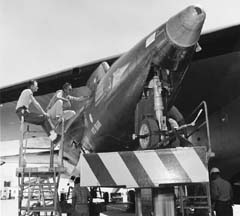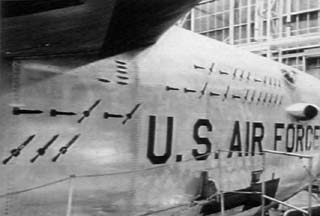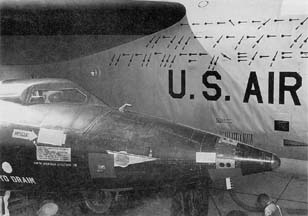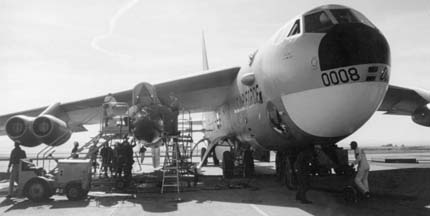 Following the achievement of the
X-15's design maximum mach number on November 9, 1961, the
emphasis of the program shifted from envelope expansion to flight
research at high mach numbers and altitudes.
Following the achievement of the
X-15's design maximum mach number on November 9, 1961, the
emphasis of the program shifted from envelope expansion to flight
research at high mach numbers and altitudes.
Forty Years ago in the X-15 Flight Test Program, November 1961 - March 1962 |
 Following the achievement of the
X-15's design maximum mach number on November 9, 1961, the
emphasis of the program shifted from envelope expansion to flight
research at high mach numbers and altitudes.
Following the achievement of the
X-15's design maximum mach number on November 9, 1961, the
emphasis of the program shifted from envelope expansion to flight
research at high mach numbers and altitudes.
Repairs to the X-15-3 were completed by North American at El Segundo, and it returned to Edwards Air Force Base for its first flight a year and a half after it exploded in the rocket engine test stand. The X-15-3 was equipped with a unique Minneapolis-Honeywell MH-96 adaptive gain flight control system for high altitude flights out of the atmosphere. The MH-96 automatically blended the aerodynamic and reaction controls. The system compensated for the reduction in effectiveness of the aerodynamic controls as altitude increased.
In order to perform airborne system tests of the NB-52 without requiring an X-15 to be mated to the Stratofortress, technicians at the Air Force Flight Test Center created an instrumented pod that simulated the systems of the X-15. It was constructed from an external fuel tank left over from the North American F-107 program and fit the connections of the X-15 pylon. It also contained accelerometers to measure the accelerations imposed on the X-15 while it was being carried by the NB-52s. Captain Charles Kuyk and Stanley Butchart conducted a test flight of the NB-52B with the instrumented pod on December 13.
 Mating X-15-3 to the NB-52B. Photo courtesy AFFTC/HO.
Mating X-15-3 to the NB-52B. Photo courtesy AFFTC/HO.
The first flight of the X-15-3 was scheduled for 9:00 A.M. on December 19. Neil Armstrong was to make his third X-15 flight over a year after his last previous flight. The primary purposes of the flight were to evaluate the new X-15's performance at partial power and its unique Minneapolis-Honeywell MH-96 flight control system in the adaptive damper mode. The flight plan called for Armstrong to climb at 50% thrust to level flight at an altitude of 75,000 feet, then perform control input pulses to evaluate the adaptive damper and descend to a landing on Rogers Dry Lake. The adaptive reaction control thrusters were not engaged, since they would not be effective at that altitude.
Major Jack Allavie and Major Russell Bement piloted the NB-52A. Stan Butchart manned the launch panel operator's station. The first launch attempt was aborted due to problems with the inertial navigation system.
The flight was rescheduled for the following morning. The X-15-3 was launched from the NB-52A over Silver Lake, 100 nautical miles from the landing site at Rogers Dry Lake. All three axes of the inertial navigation system tripped out as Armstrong launched the X-15. It rolled sharply to the right, wobbling about both the pitch and yaw axes. Without bothering to comment, Armstrong stabilized the flight of the X-15-3 and throttled its XLR-99 engine to 50% thrust. Although hampered by a poorly functioning radio, he evaluated the adaptive gain flight control system by making a series of pre-planned control input pulses. According to the flight plan, Armstrong shut down the rocket engine after a 106.3-second burn, before all of the propellants were expended, reaching a mach number of only 3.76 (2,502 miles per hour) and a maximum altitude of just 81,000 feet.
Armstrong noted that the adaptive gain flight control system changed the behavior of the X-15 during landing. In the other two X-15s, the pilot would pull the stick back with constantly increasing force to maintain the desired angle of attack as the rocket plane slowed down. In the X-15-3, the pilot held the control stick centered to maintain the desired angle of attack. The X-15-3 did not display the changes in trim associated with the extension of the flap and landing gear that the X-15 pilots had become accustomed to.
Major Allavie and Major Frank Cole conducted another test flight of the NB-52B with the instrumented pod on December 22.
Major Cole and Captain Emil Sturmthal flew the NB-52B to Boeing's factory at Wichita. for maintenance on January 2, 1962.
 The NB-52B in late 1961, shortly before delivery to Boeing in
Wichita. The last mission mark on the lowest row represents
mission 2-21-37, flown on November 9, 1961, the first flight to
achieve mach 6. There are six pod flight symbols just below the
leading edge of the wing. The entire airframe of the NB-52B would
be painted silver while it was undergoing maintenance. The X-15
mission marks would be replaced with a more compact rendering,
stacking the horizontal captive carry symbols between the angled
powered flight symbols. Source: National Air and Space Museum
Archival Videodisc 1, Side B, Frame 12571.
The NB-52B in late 1961, shortly before delivery to Boeing in
Wichita. The last mission mark on the lowest row represents
mission 2-21-37, flown on November 9, 1961, the first flight to
achieve mach 6. There are six pod flight symbols just below the
leading edge of the wing. The entire airframe of the NB-52B would
be painted silver while it was undergoing maintenance. The X-15
mission marks would be replaced with a more compact rendering,
stacking the horizontal captive carry symbols between the angled
powered flight symbols. Source: National Air and Space Museum
Archival Videodisc 1, Side B, Frame 12571.
Navy Commander Forrest Petersen's fourth and last X-15 flight was scheduled for January 10, 1962. His flight plan called for him to use 100% throttle to climb to 92,000 feet altitude, then throttle back to 50% thrust and climb while accelerating to mach 5.7 at an altitude of 110,000 feet, at which time the X-15-1's fuel would be expended. After burn out he was to continue in a ballistic trajectory to a maximum altitude of 117,000 feet.
The launch was delayed for two hours due to difficulties achieving an erection of the stable table. Major Jack Allavie and Lieutenant Colonel Don Anderson launched Commaner Petersen on mission 1-25-44 over Mud Lake about 200 miles from Edwards Air Force Base.
The XLR-99 engine of the X-15-1 shut down immediately after starting. Commander Petersen cycled through the start sequence a second time. The process of restarting the engine took 10 to 15 seconds, all the while the X-15 was descending at over 10,000 feet per minute. The engine started momentarily a second time, but shut down again. Petersen lowered the nose of the X-15 and started jettisoning his propellants. He glided in a left hand, 180-degree turn to Mud Lake, where he made the first landing of the X-15 away from Edwards Air Force Base less than four minutes after launch. A general aviation pilot in a lightplane saw the emergency landing of the X-15 and proceeded to circle the dry lake to get a better view.
Commender Peterson left the X-15 program after this flight. There were no further X-15 flights made by Navy pilots.
The second flight of the X-15-3 was scheduled for January 16, 1962. The primary purpose of the flight was another evaluation of the MH-96 flight control systrem by Neil Armstrong. The flight plan called for launch over Mud Lake followed by a climb at 75% thrust to level flight at an altitude of 100,000 feet. Armstrong was to accelerate to mach 5 before shutting down the engine after a 100-second burn. He was to make a series of yaw, pitch, and roll inputs to evaluate the response of the adaptive gain flight control system.
Edwards Air Force Base was overcast on January 16, so the second flight of the X-15-3 was postponed until the following day. It was still overcast the next morning, but the clouds cleared after delaying the launch by an hour. Once again, Major Jack Allavie and Major Russell Bement piloted the NB-52A while Stan Butchart manned the launch panel operator's station. This time the MH-96 control system did not disengage during the launch of the X-15. Armstrong's trajectory was higher and faster than planned. He shut down the engine after 97 seconds. The X-15-3 was going mach 5.51 (3,765 miles per hour) at an altitude of 117,000 feet at engine shut down. Since his speed was 1/2-mach higher than planned, Armstrong kept the nose up to avoid overstressing the airframe. That resulted in a maximum altitude 33,000 feet higher than the 100,000 feet specified in the flight plan.
 The X-15 silhouette painted on the scoreboard of the NB-52A to
represent mission 3-2-3 should be in the bottom row, just to the
left of the stack of three horizontal silhouettes. For some
reason, that symbol was angled downward with two exhaust puffs in
place of the triangle that usually denoted a powered flight. It
appears that the order of the symbols for Rushworth's emergency
landing in the X-15-1 on January 10 and Armstrong's successful
flight in the X-15-3 on January 17 may have been reversed in
order in the scoreboard.
The X-15 silhouette painted on the scoreboard of the NB-52A to
represent mission 3-2-3 should be in the bottom row, just to the
left of the stack of three horizontal silhouettes. For some
reason, that symbol was angled downward with two exhaust puffs in
place of the triangle that usually denoted a powered flight. It
appears that the order of the symbols for Rushworth's emergency
landing in the X-15-1 on January 10 and Armstrong's successful
flight in the X-15-3 on January 17 may have been reversed in
order in the scoreboard.
The winter rains made Rogers Lake and the emergency landing lakes too muddy to support X-15 landings until later in March. The NB-52A made three more flights in January 1962. It was flown twice in February and three times in March before the next X-15 flight. Two new pilots were introduced to the NB-52A during this period. A pilot named Phillips rode as co-pilot with Major Fitzhugh Fulton on January 25. Major Jack Allavie familiarized Earl Harper with the NB-52A on February 2.
 The
NB-52B returned from Wichita with Captain Scharon and Major
Charles Kuyk at the controls on March 21. It had been painted
silver overall. The last four digits of the Air Force serial
number, 0008, had been added on each side of the nose below the
nose radome. The original eagle nose art was painted over. A
slightly different eagle on a blue circle was painted lower on
the nose. The blue circle was no longer truncated on the top at
the edge of the area painted Day-Glo orange.
The
NB-52B returned from Wichita with Captain Scharon and Major
Charles Kuyk at the controls on March 21. It had been painted
silver overall. The last four digits of the Air Force serial
number, 0008, had been added on each side of the nose below the
nose radome. The original eagle nose art was painted over. A
slightly different eagle on a blue circle was painted lower on
the nose. The blue circle was no longer truncated on the top at
the edge of the area painted Day-Glo orange.
The X-15-3 was scheduled to make its next flight in late March. The primary purpose of the flight was to evaluate the operation of the MH-96 adaptive gain control system above nearly all of the atmosphere, particularly the MH-96 system's control of the reaction control thrusters. After launching over Hidden Hills Dry Lake, the flight plan called for Neil Armstrong to set the throttle at 75% thrust and climb at an angle of 35 degrees. He was to shut down the engine after 70 seconds at an altitude of 95,000 feet, then continue in a ballistic trajectory to an altitude of 170,000 feet.
The flight had been postponed once already when the NB-52A hauled the X-15-3 aloft on March 29. Major Fitzhugh Fulton and Captain John Campbell were at the controls of the NB-52A. Stan Butchart manned the launch panel operator's station. The stable table inertial system froze up, literally. The heat exchanger iced up resulting in an abort of the launch attempt until the next day.
On March 30, the launch team was asked to postpone the launch until 10:30 A.M., while the Air Force conducted an ejection seat test using a tranquilized bear. The ejection test itself was postponed until a later date. A hydraulic leak delayed the launch time until 1:00 P.M. The same flight crew took the X-15-3 aloft for a second launch attempt that afternoon, but a malfunction of the XLR-99 engine igniter idle resulted in another launch abort just moments before the drop.
The whole operation was repeated again on March 31, but the launch was scrubbed when the MH-96 flight control system failed analyzer test #24. In the face of repeated launch aborts, the next attempt was postponed until April 5 to allow time to troubleshoot the systems of the X-15-3 and NB-52A.
 Books about
the X-15 available from
Books about
the X-15 available from 
 X-15 (The Nasa Mission Reports)
X-15 (The Nasa Mission Reports)
 Angle of Attack : Harrison Storms and the Race to
the Moon by Mike Gray. The biography of Harrison Storms, who
was instrumental in the development and operation of the X-15.
Angle of Attack : Harrison Storms and the Race to
the Moon by Mike Gray. The biography of Harrison Storms, who
was instrumental in the development and operation of the X-15.
 At the Edge of Space : The X-15 Flight Program
by Milton O. Thompson. The story of test flying the X-15 from the
point of view of the pilot.
At the Edge of Space : The X-15 Flight Program
by Milton O. Thompson. The story of test flying the X-15 from the
point of view of the pilot.
Send a message to Brian
Go to home page of the Goleta Air & Space Museum.